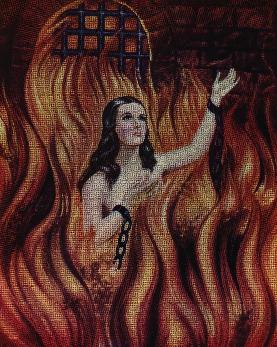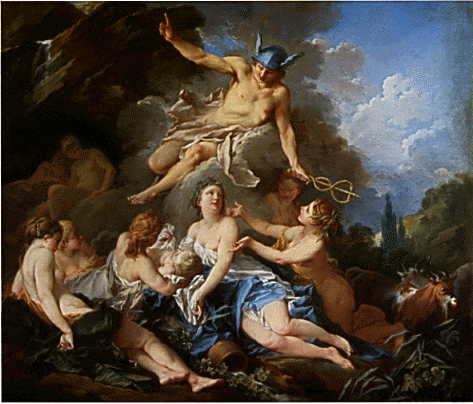

The Anima Sola is actually two different legends. In South America, she is the soul of someone involved in the crucifixion of Jesus, whose soul was condemmed to wander the earth for eternity, until the last days. In Cuba, the Anima Sola refers to Antonia Gervasio, who, unrequieted in love, chained herself and burned herself alive, and of course, is in Pergatory. The reason we mention the Anima Sola is that this image has come to correspond to certain encarnations or caminos of Eleggua. Many say that it is Alawana, but we tend to identify the Anima Sola with an Arara Eleggua or Echu named Ekubejegan. Many of the caminos of Eleggua or Echu are related to the dead. Some Elegguas are related to certain Orishas, like Alawan, who is called the "slave of Yemaya". Others are identified with Ochun, Ogun, Oddudua and many other Orishas. There are 101 different caminos or encarnations of Eleggua. Each has a different "carga" or ingredients that go inside and each is prepared somewhat differently. Some have two faces, some have three faces, there is even one that has four faces. Some are "de masa" or prepared using cement. Others are made of special woods, such as cedar, jaguey, guacamaya, etc. Some have various ceremonies that have to be prepared. Some are masculine and some are feminine. It is a complete science in itself, the preparation correctly of the different Echus or Elegguas. For that reason, we recommend that everyone receive Elegguas and Warriors from a babalawo, even though you might have Warriors of Santero, since the priests of Ifa have more knowledge to correctly prepare the different Elegguas. This is not to say the Elegguas and Warriors prepared by Santeros are not valid. Just a recommendation to make sure that everything is complete.


Hermes was the Messenger of the gods of Olympus. He is the Greek equivalent to Eleggua. He also is a trickster god, and thieves used to seek his help. He exchanged his lyre with Apollo for the gift of divination with peebles. He carried a cadeusus, or magic wand which still exists today on ambulances and other medical logos. Our Eleggua also is the messenger of the Orishas. Without his help, all communication between Orishas and indeed between Orishas and humankind would not run smoothly. One remembers the story of how Eleggua and Orunla became such good friends. Eleggua lived in the steet and was always hungry. He was envious of Orunla's and the other Orishas success and their full tables. So one day, he stood on the corner near Orunla's house, and told everyone that came to see Orunla that Orunla was not home or that he was gone on a trip. After several days, Orunla began to wonder what was going on and consulted Ifa, where he was made aware of the problem. Needless to say, he took steps to remedy the situation and Echu or Eleggua became one of Orunla's greatest allies.


When we were discussing Hermes, we neglected to mention that he is also the guide of the dead, leading them into the underworld. This was the function of Anubis, although he technically was in charge of embalming. This fits the character of Eleggua or Echu also, as we mentioned that certain caminos or encarnations of Eleggua are very closely associated with spirits of the dead. Hermes obviously evolved from Anubis, but how did he pick up the other traits of Eleggua that seemed to disappear with his correspondence with Anubis? That is a mystery we cannot explain, other than to say that the universal achetypes manifest differently in each culture or society.
CLICK HERE TO GO TO PAGE 5
HOME






